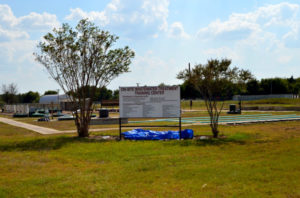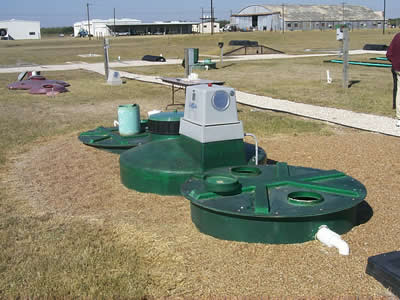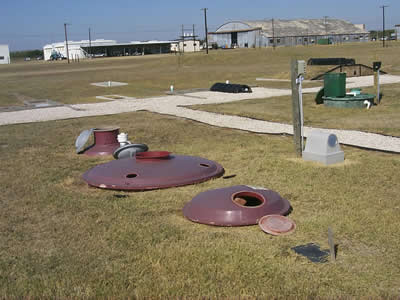We are pleased to announce that after going off-line for the past several years, the On-Site Wastewater Treatment Training Center is back on-line and ready for use once again. The Center was originally dedicated in September 1995 and served as a valuable facility for training and demonstration of On-Site Wastewater Treatment Systems (aka Septic Systems and OSSFs) until about 2008. The Center was out of order until early part of 2016.
This center provides Central Texas with many educational opportunities. The Texas Engineering Extension Service utilizes the training center for On-Site Sewage Facility (OSSF) courses. Courses are being offered for installers, inspectors, designers, regulators, site evaluators, and owners of on-site systems. The training center has been a viable resource for courses taught through Texas A&M University. Several engineering classes have toured the training center as a part of their course. The center has hosted many tours for legislators and homeowners. The Bryan center is also gaining national recognition. The center hosted two tour groups during the National On-Site Wastewater Recycling Association convention held in October 1997.
______________________________
BEGIN TOUR:
Aerobic Treatment System
The aerobic treatment process contains four main components:
- A pretreatment tank, generally referred to as the septic tank. This stage removes materials that microbes cannot degrade.
- An aeration chamber. Treatment in the aeration chamber is a biological process. The air supplied by the air pump allows microbes to thrive. The microbes consume the waste, transforming it into cell mass, non-degradable material, and gases. The chamber contains an aeration system including an air pump, piping, and diffusers to force air in and mix the cell mass with the effluent.
- A settling chamber, commonly called a “clarifier.” This allows the cell mass, which treats the water in the aeration chamber, to settle out. This clarifier also includes a method for returning the bacteria to the aeration chamber.
- The land application system distributes the treated water into the soil. Aerobic treatment units remove a large percentage of the organic matter and suspended solids from the wastewater.
______________________________
Constructed Wetland System
This system consists of a septic tank, constructed wetland, and land application system. The wetland consists of a bed of graded stone with water flowing just below the surface.
Vegetation that is adapted to saturated conditions is grown in this bed, feeding on the nutrients, organic matter, suspended solids, and pathogens in the effluent. The bed is set in a watertight basin lined with compacted native clay, bentonite clay, concrete, PVC, or a similar watertight substance.
Although both hard- and soft-tissue plants can be used in the system, some experts prefer hard-tissue plants believing they provide a pathway for oxygen to enter the wetland during winter months and hard-tissue plants reduce maintenance. However, many homeowners prefer colorful, flowering, soft-tissue plants.
_______________________________
Conventional Land Application System
The conventional land application system consists of a soil treatment area with perforated pipes surrounded by distribution media such as gravel. Effluent passes into the media and is stored there until it can be absorbed into the soil.
The microbes, decomposing the waste, form a biological mat (biomat) in the trench at the interface of the soil and the media. The biomat tends to slow down water movement into the soil creating unsaturated flow, thereby avoiding soil saturation. Microbes in the soil and biomat feed on the waste, nutrients, and pathogens remaining in the wastewater. Water leaves the system by evaporation, transpirtation, and absorption.
_______________________________
Gravel-less Pipe System
Gravel-less pipe is an option for a conventional media-filled land application system. In this system, an 8- to 10-inch corrugated polyethylene pipe is wrapped with a geotextile fabric and buried in soil. The fabric acts as a biomat interface and a wick, evenly distributing wastewater around the circumference of the pipe.
It also works to prevent backfill from entering the discharge holes on the pipe. The chief advantage to this type of system is that the pipe is flexible and lightweight. It may be placed in curved trenches fitting a specific elevation on a sloping site. However, it requires proper sizing and control of effluent quality (i.e., no scum or solids) to prevent excessive build-up of biomat on the geotextile fabric wrap.
_______________________________
Chamber System
Chambers are an alternative to a conventional media-filled land application system. A hard plastic dome supports an open reservoir that holds wastewater until it can move through the biomat and into the surrounding soil.
These chambers have greater storage capacity than media-filled systems. Also, the bottom of the dome leaves the trench open with 100% of its soil base open and available to allow absorption of the effluent.
The chambers are available in a variety of sizes and have connectors to allow construction of trenches to follow the contour of a site. Soil and site requirements for this system are similar to that of conventional media-filled trenches.
______________________________
Low-Pressure Dosing
A low-pressure dosing system requires a pump tank and a network of small-diameter pipes (1 to 2 inches) placed in trenches. The pump tank stores the effluent, and the pump intermittently doses it to the pressurized distribution network.
This pressurized system provides a relatively uniform distribution of the wastewater across the land application system. The trenches can be media-filled or constructed with chambers or other products. The trenches serve the purpose of temporarily storing the water until it can be absorbed by the soil.
_______________________________
Mound System
The mound system is ideal for areas with minimal soil between the surface and limiting condition(s) such as groundwater or bedrock. A soil treatment area is created above the natural soil surface to allow for final treatment of wastewater.
The mound has several layers including: permeable fill material (clean sand to a depth greater than 12 inches), a pressure distribution system, a cap, and topsoil. In essence, this is a traditional low-pressure dosing system built above ground level.
Its layers work in combination with the native soil to treat the wastewater. Like its traditional counterparts, it relies on the soil microbes to provide the natural treatment process.
____________________________
Subsurface Drip Dispersal System
A subsurface drip dispersal system consists of a pretreatment system, a pump tank, filtration system, subsurface drip tubing, and controller. The pump tank stores the effluent until the controller turns on the pump to dose water into the soil. The filtration system removes the large solids from the effluent and flushes the solids back to the pretreatment device.
The drip tubing is placed directly into the soil without the use of media-filled trenches. The system relies on drip tubing with emitters to reduce the water pressure before the effluent enters the soil. Since the emitters in the line have the same emission rate, wastewater is uniformly applied to the dispersal field.
The drip tubing is placed approximately 2 ft apart in the landscape so the emitters are on a grid pattern within the existing landscape. The drip lines are buried relatively shallowly so the soil can provide treatment, the landscape plants can use the nutrients and water, and the system can maximize evaporation.
_______________________________
Recirculating Media Filter System
A recirculating media filter is a method of pretreatment that provides aerobic treatment of wastewater. The wastewater is generally pumped from a pump/recirculation tank, dispersed over a media bed, and allowed to drain back into the tank. The wastewater is aerated as it flows over the media.
The media is constructed from a variety of plastics, textile, stone, or redwood laths into a number of shapes (honeycomb blocks, rings, cylinders, etc.). A biological film grown on the media feeds on the contaminants contained in the wastewater.
As the film establishes and grows, it will exceed the ability to hold onto the media. The biological materials slough off and return to the pump/recirculating tank with the wastewater for further decomposition.
END TOUR.













